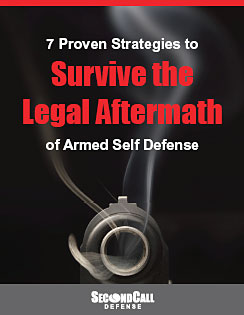Armed Encounter Fallacies from Self-Defense Advocates
by Drew Beatty
There are many fallacies pervading the culture of armed self-defense. Many of these are put forth into the marketplace of ideas by anti-gun zealots who want to motivate fear of firearms and firearms owners in the general public. This article isn’t about their fallacies, it is about ours. Proponents of armed self-defense also have pervasive cultural fallacies. Many of these will sound familiar to you.
If you shoot someone outside your house, drag them into the house to make it look like they were shot in the house.
I know I’m not the only one who has actually heard people say this, possibly in jest, possibly not. Put simply, this is evidence tampering, and may also lead to a charge of premeditated murder being filed against you. Forensic evidence doesn’t lie, and in this case, the forensic evidence would show conclusively that you shot someone on the outside of your house and dragged them inside to make it look like you shot them inside the house. How would this look to a district attorney or a jury? I suspect it would look like you are guilty of murder or manslaughter. Even if you were truly justified in this shooting, the post-shooting tampering would still be a crime serious enough to impact you for the rest of your life. This is a silly talking point that should never be taken seriously.
Only draw your firearm if you are going to shoot.
You should only draw your self-defense firearm when you are in fear of your life or serious bodily harm being done to you or others. The firearm is the last resort – always. However, if that time comes, and you end a potential deadly force encounter by drawing the weapon without firing a shot, you’ve done what you needed to do. As a responsible concealed carry holder, you are required to know the laws of self-defense in your state. I doubt any state has a law that says you can only draw if you are going to shoot.
If nobody sees you use deadly force in self-defense, simply leave the scene.
This, too will lead to your arrest and possible incarceration. Victims of a crime don’t leave the scene; they call the police to report what happened. Even if you were justified in defending yourself you may be charged with a crime. It could possibly be justified to leave the scene if you are still in fear for your own life – for instance a mob has gathered and intends to do you harm – but this is only more reason to report the incident as soon as it is safely possible to do so, and clearly state why you left the scene. You are the victim, and this needs to be communicated to authorities.
It’s justified to shoot anyone if you simply state “I was in fear.”
This is not only untrue, it is dangerously ignorant. Each state has a high bar for a judgement of lawful self-defense. Being in reasonable fear of death or serious bodily harm is a component of a judgement in your favor, but is certainly not the entirety of it. And simply saying you were in fear does not make it true. You must demonstrate clearly that any reasonable person would have done exactly what you did if they were in the same situation. You must show that the harm was unavoidable and immediate, and there was no other option than to use deadly force. A simple declaration of fear is not enough to keep you out of prison for manslaughter.
In my travels I have found that people who value the right to self-defense to be some of the most ethical and principled people I’ve ever met. However, the culture is not immune from bad information. Be sure you know what is correct and what is false before you make a mistake that could cost you treasure and freedom.
Drew Beatty is a 52-year-old lifetime resident of the great state of Colorado. He is a long-time firearms enthusiast as well as a strong advocate for The Second Amendment.
“

